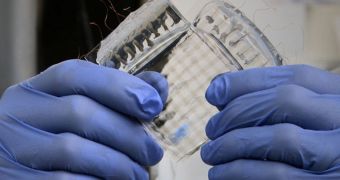Using a new approach to controlling carbon nanotubes, researchers at the Stanford University have recently created a new type of transparent, skin-like sensor. The device can be stretched by a wide margin without losing its properties.
According to the research team, the sensor can be stretched up to twice is original length, and can easily snap back into shape once released. This is made possible by the fact that the carbon nanotubes within are created in such a way that they act as springs.
Stanford scientists believe that this new device could have significant applications in the fields of touch-sensitive computer displays, prosthetic limbs and robotics, among many others. The sensor was developed by associate professor of chemical engineering Zhenan Bao and his team.
The pressure sensor appears transparent even if it is actually made up of single-walled carbon nanotubes (SWCNT). Since the small structures are fashioned in the shape of tiny springs, they are able to measure even the slightest force being applied on them.
“This sensor can register pressure ranging from a firm pinch between your thumb and forefinger to twice the pressure exerted by an elephant standing on one foot,” explains researcher Darren Lipomi.
“None of it causes any permanent deformation,” adds the science team member, who is a postdoctoral researcher in Bao's lab at the university. Chemical engineering graduate student Michael Vosgueritchian, and electrical engineering graduate student Benjamin Tee were also part of the team.
A scientific paper describing the sensor was published in the October 23 issue of the top scientific journal Nature Nanotechnology. The team explains that the SWCNT layer that covers the device is obtained by spraying the nanoscale tubes on a thin layer of silicon, which is then stretched mechanically.
The springs are obtained through this stretching process. When they are first deposited on the silicone, the CNT have random orientations. By stretching the silicon substrate, most of the tubes align themselves with the direction of the stretch.
As the silicon is released, the CNT buckle up into nanoscale structures that resemble springs. “After we have done this kind of pre-stretching to the nanotubes, they behave like springs and can be stretched again and again, without any permanent change in shape,” Bao explains.
“We did not spend very much time trying to optimize the sensitivity aspect on this sensor. We just need to make some modifications to the surface of the electrode so that we can have that same sensitivity,” he concludes.

 14 DAY TRIAL //
14 DAY TRIAL //